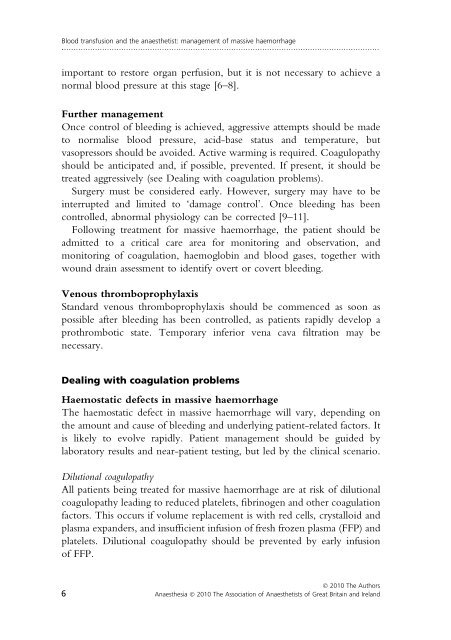Blood transfusion and the anaesthetist: management of ... - aagbi
Blood transfusion and the anaesthetist: management of ... - aagbi
Blood transfusion and the anaesthetist: management of ... - aagbi
You also want an ePaper? Increase the reach of your titles
YUMPU automatically turns print PDFs into web optimized ePapers that Google loves.
<strong>Blood</strong> <strong>transfusion</strong> <strong>and</strong> <strong>the</strong> anaes<strong>the</strong>tist: <strong>management</strong> <strong>of</strong> massive haemorrhage<br />
.....................................................................................................................................<br />
important to restore organ perfusion, but it is not necessary to achieve a<br />
normal blood pressure at this stage [6–8].<br />
Fur<strong>the</strong>r <strong>management</strong><br />
Once control <strong>of</strong> bleeding is achieved, aggressive attempts should be made<br />
to normalise blood pressure, acid-base status <strong>and</strong> temperature, but<br />
vasopressors should be avoided. Active warming is required. Coagulopathy<br />
should be anticipated <strong>and</strong>, if possible, prevented. If present, it should be<br />
treated aggressively (see Dealing with coagulation problems).<br />
Surgery must be considered early. However, surgery may have to be<br />
interrupted <strong>and</strong> limited to ‘damage control’. Once bleeding has been<br />
controlled, abnormal physiology can be corrected [9–11].<br />
Following treatment for massive haemorrhage, <strong>the</strong> patient should be<br />
admitted to a critical care area for monitoring <strong>and</strong> observation, <strong>and</strong><br />
monitoring <strong>of</strong> coagulation, haemoglobin <strong>and</strong> blood gases, toge<strong>the</strong>r with<br />
wound drain assessment to identify overt or covert bleeding.<br />
Venous thromboprophylaxis<br />
St<strong>and</strong>ard venous thromboprophylaxis should be commenced as soon as<br />
possible after bleeding has been controlled, as patients rapidly develop a<br />
prothrombotic state. Temporary inferior vena cava filtration may be<br />
necessary.<br />
Dealing with coagulation problems<br />
Haemostatic defects in massive haemorrhage<br />
The haemostatic defect in massive haemorrhage will vary, depending on<br />
<strong>the</strong> amount <strong>and</strong> cause <strong>of</strong> bleeding <strong>and</strong> underlying patient-related factors. It<br />
is likely to evolve rapidly. Patient <strong>management</strong> should be guided by<br />
laboratory results <strong>and</strong> near-patient testing, but led by <strong>the</strong> clinical scenario.<br />
Dilutional coagulopathy<br />
All patients being treated for massive haemorrhage are at risk <strong>of</strong> dilutional<br />
coagulopathy leading to reduced platelets, fibrinogen <strong>and</strong> o<strong>the</strong>r coagulation<br />
factors. This occurs if volume replacement is with red cells, crystalloid <strong>and</strong><br />
plasma exp<strong>and</strong>ers, <strong>and</strong> insufficient infusion <strong>of</strong> fresh frozen plasma (FFP) <strong>and</strong><br />
platelets. Dilutional coagulopathy should be prevented by early infusion<br />
<strong>of</strong> FFP.<br />
Ó 2010 The Authors<br />
6 Anaes<strong>the</strong>sia Ó 2010 The Association <strong>of</strong> Anaes<strong>the</strong>tists <strong>of</strong> Great Britain <strong>and</strong> Irel<strong>and</strong>

















